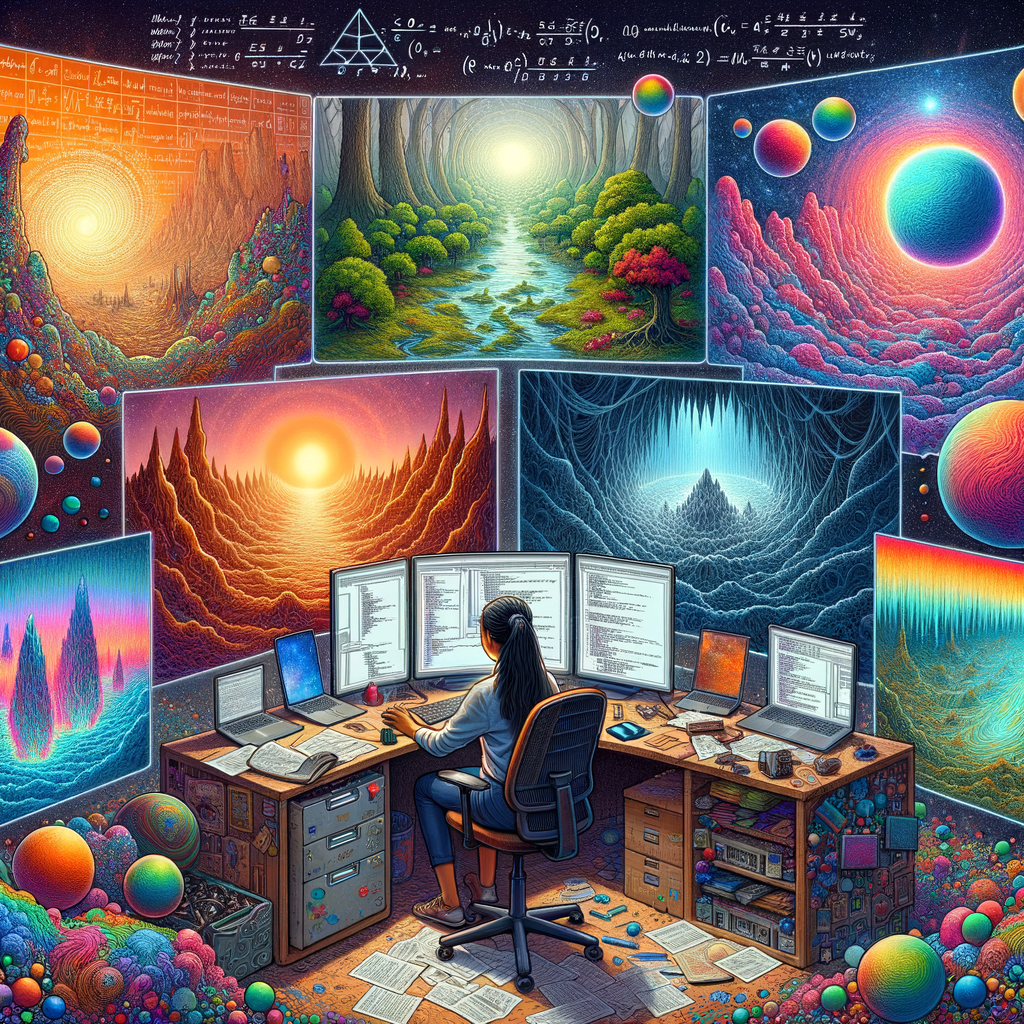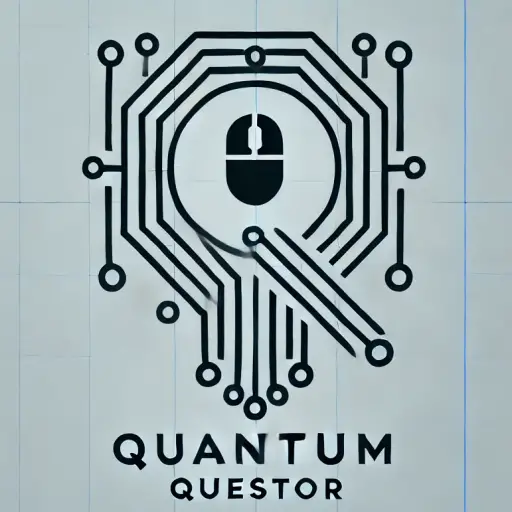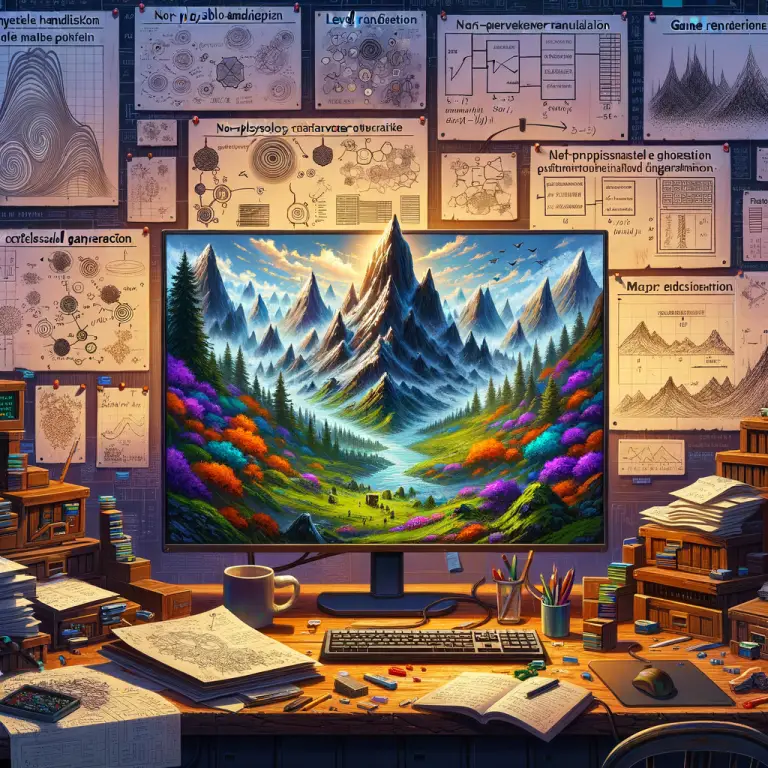
This guide blends 20 years of hands-on software engineering with some AI-assisted research to dig deep into procedural generation—what it is, how it works, and how you can use it to create vast, dynamic game worlds.
Introduction: How Algorithms Are Reshaping Games
Imagine launching a game and stepping into a world that’s never existed before. Every mountain range, riverbank, or cave system was shaped not by an artist’s hand, but by math. By code. This is procedural generation—and it’s everywhere now.
I’ve been in software engineering long enough to remember when procedural generation was a trick to save space. Today? It’s a key pillar of creative design, powering everything from endless galaxies to randomized dungeons. It lets small teams build massive, reactive, living worlds that wouldn’t be possible by hand.
What Is Procedural Generation? Let’s Break It Down
At its core, procedural generation means creating content with algorithms rather than artists. Think about writing code that knows how to grow a tree, then telling it to grow a thousand different ones.
Instead of modeling every boulder manually, we define rules. We guide randomness. The computer fills in the gaps—following a structure, but with endless variation.
Under the Hood: How the Math Works
Much of procedural generation is powered by noise functions. These create randomness, but controlled. A favourite is Perlin noise—it’s behind a lot of the organic-looking terrain in games.
Here’s a quick Python demo of how that can work:
import numpy as np
from noise import pnoise2
import matplotlib.pyplot as plt
def generate_terrain(width, height, scale=0.1, octaves=6, persistence=0.5):
terrain = np.zeros((height, width))
for y in range(height):
for x in range(width):
terrain[y][x] = pnoise2(
x * scale, y * scale, octaves=octaves,
persistence=persistence, lacunarity=2.0,
repeatx=width, repeaty=height, base=0
)
return terrain
terrain_map = generate_terrain(256, 256)
plt.imshow(terrain_map, cmap='terrain')
plt.colorbar(label='Elevation')
plt.title('Procedurally Generated Terrain')
plt.show()
Code language: JavaScript (javascript)This gives you layered noise—smooth hills, natural ridges. You’re building complexity by combining multiple scales. It’s called octave layering.
Common Pitfalls (and How to Dodge Them)
Mistake 1: Chaos Without Control
If you throw in pure randomness, you’ll likely get something messy. Unplayable. Maybe even unrecognizable.
You need structure. Templates. Constraints. A safety net that guides your randomness into something usable.
def validate_dungeon_room(room):
return is_reachable(room) and has_minimum_space(room)
def generate_valid_room():
for _ in range(100):
room = generate_random_room()
if validate_dungeon_room(room):
return room
return get_template_room() # fallback if randomness fails
Code language: PHP (php)Mistake 2: Close Enough Isn’t Good Enough
Players feel when something’s off. Rivers that flow uphill. Forests in perfect rows. It doesn’t look right because nature doesn’t work that way.
Look at real-world references. Design rules around them. It makes a huge difference.
Mistake 3: Performance Pain
Too many devs run into this. Your generator is awesome—but it freezes the game. Or it takes 30 seconds to load a level.
Fix it with async generation and caching. Here’s a starter idea:
import threading
import queue
class AsyncTerrainGenerator:
def __init__(self):
self.queue = queue.Queue()
self.cache = {}
threading.Thread(target=self.worker, daemon=True).start()
def request_chunk(self, x, y):
if (x, y) in self.cache:
return self.cache[(x, y)]
self.queue.put((x, y))
return None
def worker(self):
while True:
x, y = self.queue.get()
self.cache[(x, y)] = generate_terrain_chunk(x, y)
self.queue.task_done()
Advanced Techniques to Take It Further
Wave Function Collapse (WFC)
This one’s a beauty. It generates patterns based on examples, using constraints to make sure everything fits.
def wave_function_collapse(width, height, tiles, adjacency_rules):
grid = [[set(tiles) for _ in range(width)] for _ in range(height)]
while not is_collapsed(grid):
x, y = find_minimum_entropy_cell(grid)
chosen = random.choice(list(grid[y][x]))
grid[y][x] = {chosen}
propagate_constraints(grid, x, y, adjacency_rules)
return grid
Code language: JavaScript (javascript)You give it a starting rule set. It runs with it. The result is tight and logical—and often beautiful.
Grammar-Based Content
Great for quests, lore, or names. It builds complexity from reusable building blocks.
class ContentGrammar:
def __init__(self):
self.rules = {
'quest': ['fetch_quest', 'kill_quest', 'escort_quest'],
'fetch_quest': ['Go to {location} and bring back {item}'],
'kill_quest': ['Eliminate {enemy_count} {enemy_type} in {location}'],
'location': ['the Dark Forest', 'Crystal Caves', 'Ancient Ruins'],
'item': ['the Sacred Gem', 'rare herbs', 'ancient scroll'],
'enemy_type': ['goblins', 'undead', 'wild beasts'],
'enemy_count': ['5', '10', 'all']
}
def generate(self, symbol='quest'):
if symbol not in self.rules:
return symbol
template = random.choice(self.rules[symbol])
while '{' in template:
start = template.find('{')
end = template.find('}', start)
key = template[start+1:end]
replacement = self.generate(key)
template = template[:start] + replacement + template[end+1:]
return template
The Big Questions in Procedural Design
“It Feels Empty…”
This is the Starfield problem. You have infinite content, but little emotional pull. Random caves and alien worlds don’t automatically make for fun experiences.
Balance is key. Use procedural generation to do the heavy lifting, but layer in curated moments. A hand-placed ruin here. A story-driven twist there.
AI’s Role in the Future
Machine learning is creeping into procedural generation. Instead of writing rules, you train models on what good content looks like. The results? Wildly varied. Often promising. Sometimes unusable.
This is the frontier. It’s powerful, but not fully controllable. Use with caution.
Starting Your Own Procedural System
Great Libraries to Explore
noise– Perlin and Simplex noiseNumPy– Matrix mathPillow– Image output and renderingp5.js– For browser-based experiments
A Fun Beginner Project
Let’s end with something playful: a fantasy name generator.
class NameGenerator:
def __init__(self):
self.prefixes = ['Aer', 'Dun', 'Fel', 'Kor', 'Mal', 'Nor']
self.suffixes = ['ath', 'dor', 'helm', 'keep', 'wyn']
self.vowels = ['a', 'e', 'i', 'o', 'u']
self.consonants = list('bcdfghjklmnpqrstvwxyz')
def generate_fantasy_name(self):
if random.random() < 0.7:
return random.choice(self.prefixes) + random.choice(self.suffixes)
else:
return self.generate_syllable_name()
def generate_syllable_name(self, min_syllables=2, max_syllables=4):
syllables = random.randint(min_syllables, max_syllables)
name = ''
for i in range(syllables):
if i == 0 or random.random() < 0.8:
syllable = random.choice(self.consonants) + random.choice(self.vowels)
else:
syllable = random.choice(self.vowels) + random.choice(self.consonants)
name += syllable.capitalize() if i == 0 else syllable.lower()
return name
gen = NameGenerator()
for _ in range(10):
print(gen.generate_fantasy_name())
Final Thoughts
Procedural generation isn’t just about making things faster. It’s about building the impossible. Creating worlds with rules instead of rigid design. Making space for surprise and scale.
If you balance algorithms with insight—randomness with restraint—you’ll find it opens doors you didn’t know existed.
You don’t have to handcraft every detail. Just build the rules. The universe will follow.
Curated by a human, assisted by AI. Built on two decades of engineering insight and a love for creative systems.



